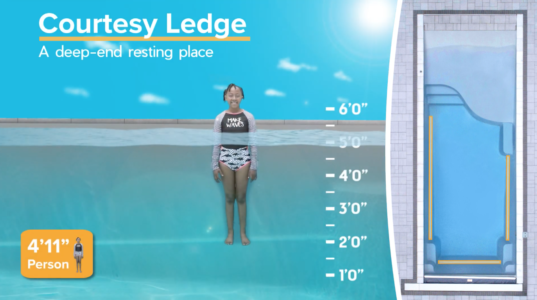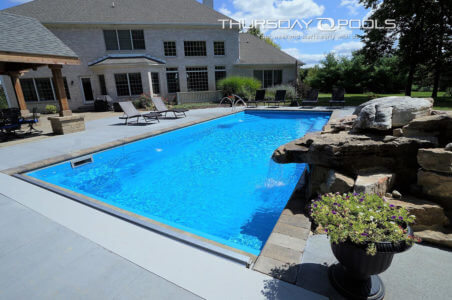 Grace. It can mean courteous goodwill and simple elegance or refinement of movement.
Grace. It can mean courteous goodwill and simple elegance or refinement of movement.
Meet our Grace. The Grace Beach Entry Fiberglass Pool (Patent US 10,472,839) gives you the feel of the beach and the simple elegance of a luxury, rectangle-shaped pool design.
HOW IS A BEACH ENTRY FIBERGLASS POOL DIFFERENT?
A beach entry, or zero-entry pool, is an inground swimming pool designed with an entry that has a very slight slope into the pool, providing you with a slow, gradual entry into the water. For every seven feet in distance, the pool can have no more than one foot in depth.
If you’re looking for a pool that is easy to get into, provides great space to dip your toes in the water, or swim a few laps in the pool, the Grace Beach Entry might just be the perfect fit for the beach lover in you.
FIBERGLASS POOLS ARE THE SOCIAL CENTERPIECE OF THE 2020s
Pools are now and will likely continue to be social hubs—a place where friends and family can gather to enjoy time together that turns into the fondest memories. Creating your beach atmosphere with the Grace Beach Entry fiberglass pool as the centerpiece is only limited by your imagination.
A word of caution: Inground fiberglass pools have been associated with extremely high levels of entertainment, joy, and fun. Check with your doctor to ensure that your heart can withstand the excitement that a new Thursday Pools Fiberglass Inground Pool can bring.
And surely your mother told you to wait 30 minutes after eating before you swim. That has never been a proven thing but listen to your mother.
FIND OUT ALL ABOUT GRACE BEACH ENTRY TO SEE IF IT’S FOR YOU
The Grace Beach Entry comes in three sizes.



Grace Beach Entry has enough room for all the beach lovers in your life. Let’s see how you can enjoy it.
 1. Beach entry. The zero-entry transition brings the shore to your door. Want to tan without sitting in the water? The gentle slope itself makes a great tanning area or two ledge loungers fit nicely in the beach entry area while providing swimmers plenty of room to enter and exit the pool.
1. Beach entry. The zero-entry transition brings the shore to your door. Want to tan without sitting in the water? The gentle slope itself makes a great tanning area or two ledge loungers fit nicely in the beach entry area while providing swimmers plenty of room to enter and exit the pool.
 2. Wading area. Step a little further into the beach entry and you’ve got a wading area to cool off. Plus, it can double as a play area for smaller children.
2. Wading area. Step a little further into the beach entry and you’ve got a wading area to cool off. Plus, it can double as a play area for smaller children.
 3. Wide-open non-skid steps. The steps’ non-skid surface provides sure footing to exit and enter the pool. A young child that’s 4’5” in height will find the water comes up just to the neckline when standing at the bottom of the steps.
3. Wide-open non-skid steps. The steps’ non-skid surface provides sure footing to exit and enter the pool. A young child that’s 4’5” in height will find the water comes up just to the neckline when standing at the bottom of the steps.
 4. Extended Bench. The extended bench provides a nice area to relax and take a break from your water exercise routine or enjoy conversation with some friends.
4. Extended Bench. The extended bench provides a nice area to relax and take a break from your water exercise routine or enjoy conversation with some friends.
 5. Dual deep-end swim-outs. The Grace Beach Entry Fiberglass pool offers two deep-end swim-outs that can be used for exiting the pool or just chilling out. Your kids might find some other fun uses for them as well.
5. Dual deep-end swim-outs. The Grace Beach Entry Fiberglass pool offers two deep-end swim-outs that can be used for exiting the pool or just chilling out. Your kids might find some other fun uses for them as well.
 6. Wide-open swim or play area. Are you looking to stay in shape and ensure a long life? Grace Beach Entry provides plenty of space to get those laps in or enjoy some other fun sports.
6. Wide-open swim or play area. Are you looking to stay in shape and ensure a long life? Grace Beach Entry provides plenty of space to get those laps in or enjoy some other fun sports.
 7. Courtesy Ledge. The courtesy ledge extends around the entire deep end of the pool and provides places to stand and take a break from swimming.
7. Courtesy Ledge. The courtesy ledge extends around the entire deep end of the pool and provides places to stand and take a break from swimming.
8. Auto-cover ready. Like the Sandal, Grace Beach Entry fiberglass pool is auto-cover ready. Automatic pool safety covers are a fabulous choice for inground fiberglass pool owners. They ensure that no one can enter the pool without your knowledge, reduce time spent on pool maintenance, and lower your maintenance costs.
Ready to get an estimate or contact a dealer?
See for yourself what a beach entry fiberglass pool is by taking a 360 tour of the Grace Beach Entry fiberglass pool.
See where the water comes up to you from different areas of the pool.
Do you wonder where the water might hit you (or your family members) based on your height? Our wet tour will give you a sense of what it feels like as you enjoy every aspect of this artfully crafted pool.
How much does the Grace Beach Entry fiberglass inground pool cost?
Fiberglass inground pool prices will vary based on a variety of factors, including where you live and how accessible your yard is. You’ll need to contact a Thursday Pools dealer for an actual estimate, but you can usually plan on about $1500 per linear foot for most pools, including installation. However, for the beach entry designs, the cost will likely run you about 15 to 20 percent more. To get a more in-depth view of inground pool project costs, try our handy Pool Cost Calculator.
Are you ready to find a Thursday Pools dealer near you?
Thursday Pools fiberglass pools are available throughout the U.S., in Alabama, Arkansas, Colorado, Connecticut, Delaware, Georgia, Illinois, Indiana, Iowa, Kansas, Kentucky, Louisiana, Maryland, Massachusetts, Michigan, Minnesota, Mississippi, Missouri, Nebraska, New Hampshire, New Jersey, New York, North Carolina, Ohio, Oklahoma, Pennsylvania, South Carolina, Tennessee, Texas, Utah, Virginia, Washington, West Virginia, Wisconsin, and Ontario, Canada.
Thursday Pools designs and manufactures fiberglass pool shells that are handcrafted with the highest standards and craftsmanship. Our one-piece, inground fiberglass swimming pool manufacturing facility is based out of Fortville, Indiana. At Thursday Pools, we aspire to be the world’s most respected fiberglass pool manufacturer. Our innovations, commitment to quality, and beautiful designs set us apart. Thursday Pools is known for its innovations within the fiberglass pool industry, such as the beach entry (or zero entry) fiberglass pool (Patent US 10,472,839), as well as the fiberglass sunken living room pool. Get inspired about a backyard swimming pool oasis of your own and get a free estimate on the fiberglass pool of your dreams today. Making that dream a reality is easier than you might think. Thursday Pools: your weekend starts early with us!






 maintaining it isn’t lazy. It’s smart.
maintaining it isn’t lazy. It’s smart. 
 thing to help you accomplish those goals. Water exercise has loads of health benefits, including weight loss, increased strength and muscle tone, joint pain relief, improved cardiovascular health, reduced stress, and increased fun (which is also very good for you!)
thing to help you accomplish those goals. Water exercise has loads of health benefits, including weight loss, increased strength and muscle tone, joint pain relief, improved cardiovascular health, reduced stress, and increased fun (which is also very good for you!)  Ready to wade on in?
Ready to wade on in?